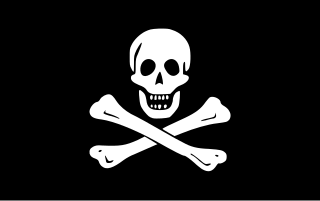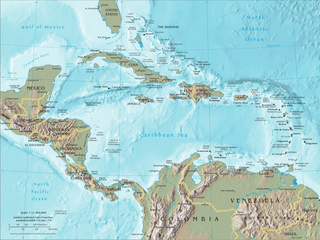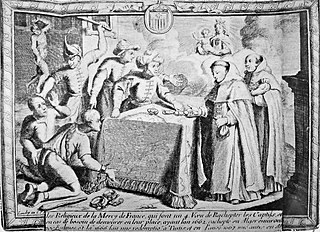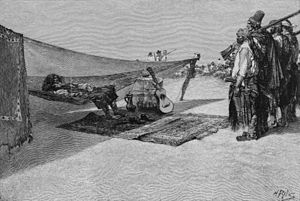
Piracy is an act of robbery or criminal violence by ship or boat-borne attackers upon another ship or a coastal area, typically with the goal of stealing cargo and other valuable goods. Those who conduct acts of piracy are called pirates, vessels used for piracy are pirate ships. The earliest documented instances of piracy were in the 14th century BC, when the Sea Peoples, a group of ocean raiders, attacked the ships of the Aegean and Mediterranean civilisations. Narrow channels which funnel shipping into predictable routes have long created opportunities for piracy, as well as for privateering and commerce raiding.

Buccaneers were a kind of privateer or free sailors particular to the Caribbean Sea during the 17th and 18th centuries. First established on northern Hispaniola as early as 1625, their heyday was from the Restoration in 1660 until about 1688, during a time when governments in the Caribbean area were not strong enough to suppress them.

A privateer is a private person or vessel which engages in maritime warfare under a commission of war. Since robbery under arms was a common aspect of seaborne trade, until the early 19th century all merchant ships carried arms. A sovereign or delegated authority issued commissions, also referred to as letters of marque, during wartime. The commission empowered the holder to carry on all forms of hostility permissible at sea by the usages of war. This included attacking foreign vessels and taking them as prizes and taking crews prisoner for exchange. Captured ships were subject to condemnation and sale under prize law, with the proceeds divided by percentage between the privateer's sponsors, shipowners, captains and crew. A percentage share usually went to the issuer of the commission.

Sir Henry Morgan was a Welsh privateer, plantation owner, and, later, Lieutenant Governor of Jamaica. From his base in Port Royal, Jamaica, he raided settlements and shipping on the Spanish Main, becoming wealthy as he did so. With the prize money from the raids, he purchased three large sugar plantations on the island.

The era of piracy in the Caribbean began in the 1500s and phased out in the 1830s after the navies of the nations of Western Europe and North America with colonies in the Caribbean began combating pirates. The period during which pirates were most successful was from the 1660s to 1730s. Piracy flourished in the Caribbean because of the existence of pirate seaports such as Port Royal in Jamaica, Tortuga in Haiti, and Nassau in the Bahamas. Piracy in the Caribbean was part of a larger historical phenomenon of piracy, as it existed close to major trade and exploration routes in almost all the five oceans.

Port Royal is a town located at the end of the Palisadoes, at the mouth of Kingston Harbour, in southeastern Jamaica. Founded in 1494 by the Spanish, it was once the largest city in the Caribbean, functioning as the centre of shipping and commerce in the Caribbean Sea by the latter half of the 17th century. It was destroyed by an earthquake on 7 June 1692, which had an accompanying tsunami, leading to the establishment of Kingston, which is now the largest city in Jamaica. Severe hurricanes have regularly damaged the area. Another severe earthquake occurred in 1907.

Tortuga Island is a Caribbean island that forms part of Haiti, off the northwest coast of Hispaniola. It constitutes the commune of Île de la Tortue in the Port-de-Paix arrondissement of the Nord-Ouest department of Haiti.
This timeline of the history of piracy in the 1680s is a chronological list of key events involving pirates between 1680 and 1689.

Jean-David Nau, better known as François l'Olonnais, was a French pirate active in the Caribbean during the 1660s.

The Golden Age of Piracy is a common designation for the period between the 1650s and the 1730s, when maritime piracy was a significant factor in the histories of the North Atlantic and Indian Oceans.
This timeline of the history of piracy in the 1650s is a chronological list of key events involving pirates between 1650 and 1659.
Captain John Coxon, sometimes referred to as John Coxen, was a late-seventeenth-century buccaneer who terrorized the Spanish Main. Coxon was one of the most famous of the Brethren of the Coast, a loose consortium of pirates and privateers. Coxon lived during the Buccaneering Age of Piracy.

Edward Mansvelt or Mansfield was a 17th-century Dutch corsair and buccaneer who, at one time, was acknowledged as an informal chieftain of the "Brethren of the Coast". He was the first to organise large scale raids against Spanish settlements, tactics which would be utilised to attack Spanish strongholds by later buccaneers in future years, and held considerable influence in Tortuga and Port Royal. He was widely considered one of the finest buccaneers of his day and, following his death, his position was assumed by his protégé and vice-admiral, Henry Morgan.

Anglo-Turkish piracy or the Anglo-Barbary piracy was the collaboration between Barbary pirates and English pirates against Catholic shipping during the 17th century.

The Capture of Fort Rocher took place on 9 February 1654, during the Franco-Spanish War (1635–1659). Equipped with one siege battery, a Spanish expedition of 700 troops attacked the buccaneer stronghold of Tortuga, capturing the Fort de Rocher and 500 prisoners including 330 buccaneers and goods valued at approximately 160,000 pieces-of-eight. The Spanish burned the colony to the ground and slaughtered its inhabitants, leaving behind a fort manned by 150 soldiers. They possessed the island for about eighteen months, but on the approach of the expedition under Penn and Venables were ordered by the Conde de Peñalva, Governor of Santo Domingo, to demolish the fortifications, bury the artillery and other arms, and retire to his aid in Hispaniola.
Robert Hunt was an English soldier who was Governor of the Providence Island colony in the western Caribbean sea from 1636 to 1638.
White Haitians, also known as Euro-Haitians, are Haitians of predominant or full European descent. There were approximately 20,000 whites around the Haitian Revolution, mainly French, in Saint-Domingue. They were divided into two main groups: The Planters and Petit Blancs. The first white Europeans to settle in Haiti were the Spanish. The Spanish enslaved the indigenous Haitians to work on sugar plantations and in gold mines. European diseases such as measles and smallpox killed all but a few thousand of the indigenous Haitians. Many other indigenous Haitians died from overwork and harsh treatment in the mines from slavery. Many white people who settled in Haiti were killed or fled during the Haitian Revolution.
James Browne was a Scottish pirate and privateer active in the Caribbean. He is best known for his hasty execution and its effect on colonial Jamaican government.

The 1635 Capture of Tortuga was a successful military campaign against the Anglo-French plantation, pirate, and buccaneering settlement of Tortuga, then a dependency of the Providence Island colony. It resulted in heavy casualties for the settlement, the severance of Tortuga's link with Providence Island, and Tortuga's further shift towards piracy and buccaneering.














